WALTER WELLAND
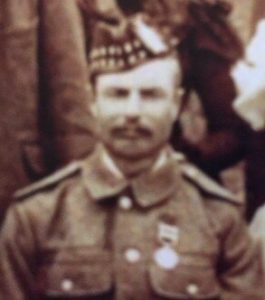 Subject Name: Walter Welland (b1870 – d1938)
Subject Name: Walter Welland (b1870 – d1938)
Researcher: Viv Bennett
Walter William Welland was just five years old when his father passed away, leading to a spell in the Guildford Union Workhouse with his mother Mercy and sister Lucy Ann. His life in the Army began disastrously leading to imprisonment, before successfully serving in India and South Africa. Marriage, emigration to Canada, raising ten children and another spell in the Forces during World War One saw Walter make a great success of his life after such a difficult beginning.
Walter was the first child of Isaac and Mercy Welland. He was born on 27th January 1870 in Eashing, Surrey, and baptised on 24th April 1870 at St Mary’s Church, Shackleford.
His parents had been living at Edenbridge in Kent when they married in 1867, but had moved some 35 miles (56km) west to Eashing sometime before Walter was born. Eashing is just outside Godalming, the birthplace of Walter’s father Isaac.
The family were not to remain in Eashing for long, as by the time of the 1871 Census, they had moved to the Old Forge, Lingfield, Surrey, just a short distance from Edenbridge on the Kent border, and where Walter’s mother had been born. Walter was one year old, his mother 32 with his 34-year-old father Isaac noted as a cleaver.
Isaac’s occupation, its full name being a lath cleaver or lath render, involved cutting wood to make laths for use in the building industry. He may have had to move around where work was required because in 1872, the family were living in Limpsfield, Surrey, about ten miles (16km) north of Lingfield. It was clear that the family were poor as they were presented with a Removal Order from Limpsfield to Isaac’s birth parish of Godalming. The Guildford Union Workhouse minutes for 6th July 1872 stated: “The Clerk produced an order for the removal of Isaac Welland, his wife and child from Limpsfield in the Godstone Union to Godalming in this Union and reported from enquiries he had caused to be made it appeared that no objection could successfully be made to the order”.
At this time, Walter’s mother was heavily pregnant with her second child, and his father was now seriously ill with phthisis, the 19th Century term for tuberculosis, which would almost certainly have prevented him from working and pushed the family into poverty. Before the Removal Order could be implemented, Mercy gave birth in Limpsfield to a daughter, Lucy Ann, on 22nd August 1872. Tragically, just 29 days later on 20th September, Walter’s father Isaac died age 37. He was buried at St. Peter’s Church, Limpsfield on 25th September. Just four days later, Mercy returned to St. Peter’s for the baptism of her daughter.
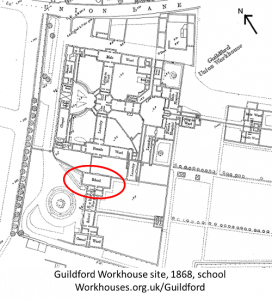 Despite the death of his father, Walter, his mother Mercy and baby sister Lucy were still subject to the Removal Order. There are no records to show exactly when they were admitted to the Guildford Union Workhouse, but they were noted living there in the 1881 Census. Walter, age 11, and Lucy, 8, were both recorded as scholars. There was a school within the Workhouse, so they were most likely being educated there. Their mother Mercy was noted as a 40-year-old widow of an agricultural labourer.
Despite the death of his father, Walter, his mother Mercy and baby sister Lucy were still subject to the Removal Order. There are no records to show exactly when they were admitted to the Guildford Union Workhouse, but they were noted living there in the 1881 Census. Walter, age 11, and Lucy, 8, were both recorded as scholars. There was a school within the Workhouse, so they were most likely being educated there. Their mother Mercy was noted as a 40-year-old widow of an agricultural labourer.
The children would have stayed with their mother in the female section of the Workhouse until they were seven, and then been transferred to the children’s ward. After that, the rules were that Mercy was permitted to see them once a day.
Education for Workhouse children consisted of formal lessons in the morning such as reading, writing, arithmetic, and religion. Classes were often large with few resources, so children learnt by repetition and by copying from the blackboard onto slates. In the afternoons, boys would have had practical lessons in for example carpentry, shoemaking, tailoring, and helping in the workhouse vegetable plots.
At some stage in the 1880s, probably after Walter and Lucy had both turned 13 and were old enough to earn a wage, Walter and his mother moved back to Kent, while Lucy remained in the Guildford area where she became a housemaid at a ladies’ school.
Many workhouse boys went on to join the Army, and this is also the route that Walter took. On 6th June 1889, he enlisted in Derby with the King’s Own Scottish Borderers KOSB, meeting up with them the following day in Berwick-on-Tweed. In his service records he was described as 5 foot 3 ¾ inches (1.62m) tall, weighing 110 pounds (7 stone 12 pounds/49.9kg) with a fresh complexion, grey eyes, brown hair, aged 18 years 4 months (actually 19 years 4 months), occupation a labourer and that his mother was Lucy Welland, though of course this was the name of his sister.
Not everything was well, however, as Walter deserted from the Army on 30th November 1889. After 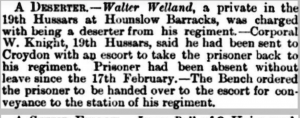 being caught, he was confined on 2nd January 1890, not for his desertion but for “fraudulent enlistment”. The little errors he made over his age or his mother’s name would not have been an issue, but what appears to have happened was that Walter had not disclosed on his attestation that he had previously been in the British Army with the 19th Hussars and had deserted from them early in 1889.
being caught, he was confined on 2nd January 1890, not for his desertion but for “fraudulent enlistment”. The little errors he made over his age or his mother’s name would not have been an issue, but what appears to have happened was that Walter had not disclosed on his attestation that he had previously been in the British Army with the 19th Hussars and had deserted from them early in 1889.
Walter was court martialled and stood trial in Edinburgh on 15th January 1890. He was found guilty and sentenced to 84 days in gaol. After release on 9th April he was able to resume serving with the KOSB.
Despite this terrible start, Walter went on to have a fine career in the Army. On 12th November 1891, 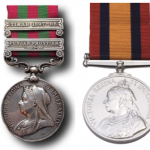 his company travelled to India where he was to remain for over six years. During this time, he was involved in the successful defence of the Tirah region on British India’s North-West Frontier (now part of Pakistan) in 1897-98 against the Afridi and Orakzai Pathan Tribes in the Khyber Pass. For this he received the India medal with clasps.
his company travelled to India where he was to remain for over six years. During this time, he was involved in the successful defence of the Tirah region on British India’s North-West Frontier (now part of Pakistan) in 1897-98 against the Afridi and Orakzai Pathan Tribes in the Khyber Pass. For this he received the India medal with clasps.
After returning to the UK in 1898, he then served in South Africa in 1900-02 during the Boer War, and was awarded the Queen’s South Africa medal. Despite the obvious dangers during his two terms overseas, he escaped with only a slight gunshot wound in his thigh. Walter returned home in June 1902, and was discharged from the Army, having completed 12 years of service, on 2nd July 1902.
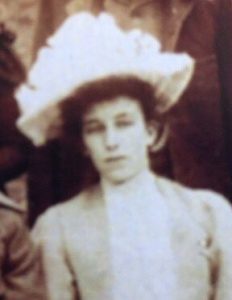 Just a few weeks later, 32-year-old Walter married Lois Robus, ten years younger than him, on 23rd August at the parish church in Westerham, Kent. He had now become a railway porter.
Just a few weeks later, 32-year-old Walter married Lois Robus, ten years younger than him, on 23rd August at the parish church in Westerham, Kent. He had now become a railway porter.
The couple soon began raising a family, with their first daughter Lois Millie, later known as just Millie, born in June 1903. Three more children followed in quick succession – Lucy Gladys May in June 1904, Kathleen Winifred in August 1905 and Walter George in October 1906. During this time, the family moved around and were living at Dollis Hill Farm in north-west London when daughter Lucy was born. Walter was noted on the birth certificate as a farm labourer, so his career as a railway porter appears to have been short-lived!
It seems that Walter was unable to settle anywhere for any length of time and maybe had a taste for living overseas after his spells in India and South Africa with the Army. Whatever his reason, the family decided to emigrate to Canada in 1907. They booked to travel on 8th June 1907 from Liverpool on the SS Vancouver to Montreal. It would have been a heart-breaking farewell as Walter’s mother Mercy was critically ill with heart disease, and just three days after Walter and his family had left England, Mercy passed away.
The family arrived in Canada on 18th June 1907 and settled in Ontario. More children continued to arrive – Arthur in April 1908 and Charlotte Ena (Lottie) in June 1910. On the 1911 Census, Walter’s wife Lois, age 31, and children Millie (7), Lucy (6), Kathleen (5), Walter (4), Arthur (3) and
Lottie (11 months) were living in Glenelg Township, about 100km north-west of Toronto. There is no mention of Walter himself on the Census, but it may well be that he was away with the Canadian Army Volunteers – he had successfully completed 12 days training with them in 1908.
Shortly after the Census, their seventh child Robert Orin was born in August 1911. He was followed by Noreen Orpha in November 1912 (33) and Freda Olive in February1914. However, Walter’s interest in military life was soon to mean that his wife Lois was going to be left alone in charge of their nine children at their latest home in Lincoln, Ontario, near Niagara Falls.
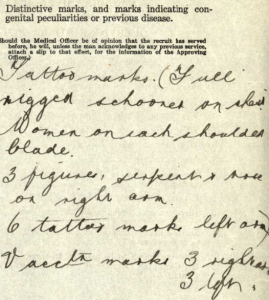 Eight months after the First World War broke out, 45-year-old Walter – although he only admitted to being 44 – enlisted for the Canadian Expeditionary Force (CEF), joining the 36th Battalion of the Canadian Infantry on 14th April 1915. His enlistment record showed that he was now well adorned with tattoos – a full-rigged schooner on his chest, a woman on each shoulder blade, and more designs, including a serpent, on each arm. He had also put on some weight since his last enlistment as a 19-year-old – he was now 130 pounds (9 stone 4 pounds/59kg).
Eight months after the First World War broke out, 45-year-old Walter – although he only admitted to being 44 – enlisted for the Canadian Expeditionary Force (CEF), joining the 36th Battalion of the Canadian Infantry on 14th April 1915. His enlistment record showed that he was now well adorned with tattoos – a full-rigged schooner on his chest, a woman on each shoulder blade, and more designs, including a serpent, on each arm. He had also put on some weight since his last enlistment as a 19-year-old – he was now 130 pounds (9 stone 4 pounds/59kg).
Walter’s unit arrived in England on 28th June 1915, going to the CEF’s Camp at West Sandling, near Folkestone, Kent. He was sent to France in October, but was invalided out of the country and returned to England two months later. Walter had not been wounded, however – rheumatism was the reason for him having to leave the Western Front. A medical examination carried out on him at Shorncliffe on 2nd June 1916 showed that he was suffering from “pain in knees, ankles and hands, joints enlarged”.
Despite this, Walter remained on active service for another 18 months, mostly as a pay orderly in the CEF’s London office, before he departed Liverpool on the SS Olympic on 31st January 1918 on his way to the 2nd Casualty Unit in Toronto. A further medical examination, at which Walter added two years to his life making him “50”, showed he had “chronic arthritis” and that he was “overage”.
Walter was finally discharged from the Army on 12th March 1918 as “physically unfit”, with his report noting that his conduct in service had been “very good”.
Life would no doubt have been tough for Walter’s family during his almost three-year absence. His pay was just $1.10 per day which could never have covered the expense of feeding a large family. The Canadian Government did provide an extra $20 per month to the wives of soldiers, but this was still barely enough. Businessman and Montreal MP Sir Herbert Ames set up the Canadian Patriotic Fund to help provide extra money for families struggling to make ends meet, with donations to this from the Canadian public raising over $47 million.
Thankfully, Walter’s family came through this time. The 1921 Census of Canada shows Walter had moved to Brighton Township on the north shore of Lake Ontario about 100 miles (160km) east of Toronto. Now 51, he was a farmer, though unfortunately, it does not say what his produce was. His wife Lois was 41, and six of their children – Walter (14), Arthur (13), Charlotte (10), Robert (9), Noreen (8) and Freda (7) – made up the rest of the household. Walter and Arthur were both noted as farmer’s sons, which presumably meant they were earning their keep there. Their house was rented, and constructed of wood.
There was still time for a tenth child, Dorothy, born on 20th May 1923, just under 20 years since her oldest sibling Millie was born.
By the time Walter had stopped working in 1928, he was living with Lois at 65 Lake St, St Catharine’s, Ontario on the south shore of Lake Ontario, about 20km from Niagara Falls.
 Walter died on 10th February 1938, age 68, from a heart condition and influenza in St Catherine’s (39) and was buried at Victoria Lawn Cemetery, Niagara. His wife Lois outlived him by some margin, dying in St Catherine’s in July 1962, age 82.
Walter died on 10th February 1938, age 68, from a heart condition and influenza in St Catherine’s (39) and was buried at Victoria Lawn Cemetery, Niagara. His wife Lois outlived him by some margin, dying in St Catherine’s in July 1962, age 82.
Walter’s life was undoubtedly a colourful one, showing a remarkable strength of character to come through a tough childhood and mistakes which led to his imprisonment to become a noted soldier and the successful father of ten children in his new home of Canada.
January 2021, updated August 2022
With many thanks to Walter’s great granddaughter Bonnie Welland-Wakulich for her kind permission to use the photographs of Walter and Lois Welland.
For more on Walter’s mother Mercy click here
For more on Walter’s sister Lucy click here
We’d love to hear from you if you are a relative of this family.
Please contact us by email: spikelives@charlotteville.co.uk
 Spike Lives is a Heritage project that chronicles the lives of inmates, staff and the Board of Guardians of the Guildford Union Workhouse at the time of the 1881 Census. The Spike Heritage Museum in Guildford offers guided tours which present a unique opportunity to discover what life was like in the Casual/Vagrant ward of a Workhouse. More information can be found here
Spike Lives is a Heritage project that chronicles the lives of inmates, staff and the Board of Guardians of the Guildford Union Workhouse at the time of the 1881 Census. The Spike Heritage Museum in Guildford offers guided tours which present a unique opportunity to discover what life was like in the Casual/Vagrant ward of a Workhouse. More information can be found here
Sources : Ancestry.co.uk / Ancestry.com / Fold3.com
FamilySearch.org.uk
Findagrave.com
FindMyPast.co.uk / British Newspaper Archives
Forces-war-records.co.uk
FreeBMD.co.uk
General Register Office gro.gov.uk
Rootschat.com
Surrey History Centre Surreycc.gov.uk
Thecanadianencylcopedia.ca
Wikipedia.org.uk
Workhouses.org.uk
For a full list of references click here.
